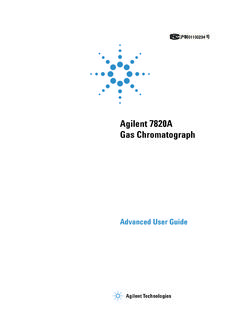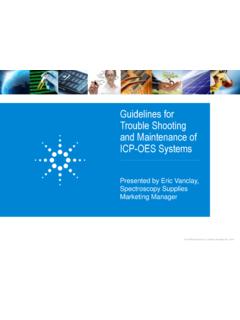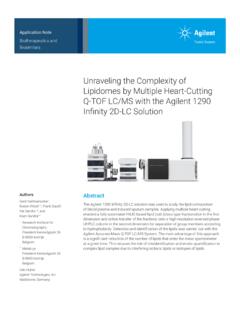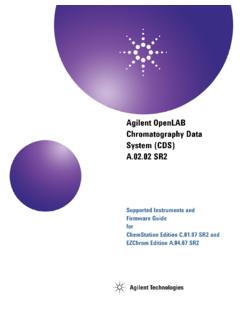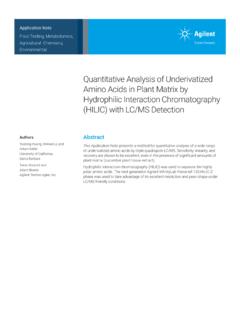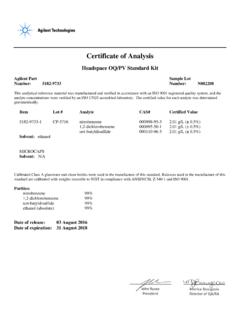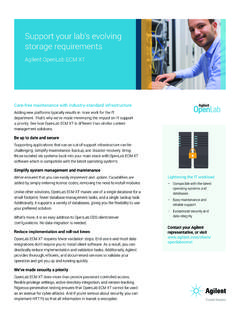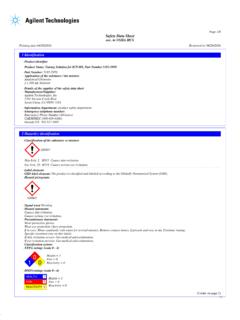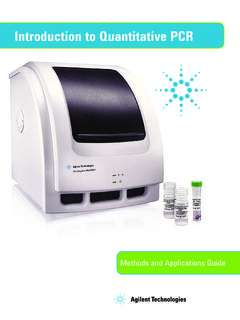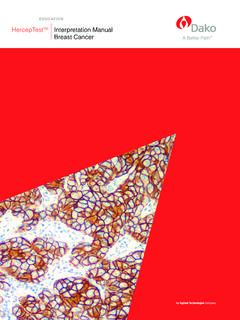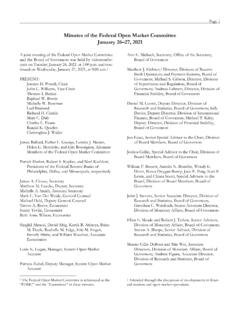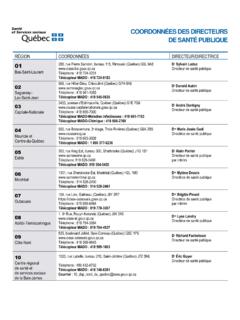Transcription of USP General Chapter <1058> - Agilent
1 USP General Chapter <1058>Compendium2> Search entire documentTable of contentsTitle PageIntroduction 3 What Has Changed with the 2017 Version of USP <1058>? 4 How to Comply with the 2017 Version of USP <1058> 16 Role of Analytical Instrument Qualification in Data Integrity with 25 2017 USP <1058>What Does Performance Qualification Really Mean? 373 The US Pharmacopeia (USP) General Chapter <1058> on Analytical Instrument qualification (AIQ) was first implemented in 2008 and remained unchanged for nine years. During 2017, the USP implemented two updates to <1058> (in August and December). These updates have a significant impact on AIQ, and as the only major pharmacopeia with a Chapter dedicated to AIQ, changes to USP <1058> are of global > Return to table of contents> Search entire documentTo help regulated laboratories fully comply with 2017 <1058> requirements, Agilent has produced four White Papers with compliance consultant Bob McDowall, who has been closely involved with the development of <1058>.
2 The series includes:1. What Has Changed with the 2017 Version of USP <1058>?12. How to Comply with the 2017 Version of USP <1058>23. The Role of Analytical Instrument Qualification in Data Integrity with the 2017 Version of USP <1058>34. What Does Performance Qualification Really Mean with the 2017 Version of USP <1058>?4 The four white papers are included in this compendium for your CrossLab compliance services helping to maintain a compliant laboratory Agilent offers a comprehensive set of laboratory compliance services. Services include: Instrument and software qualification (IQOQ, OQ and RQ) based on USP <1058> AIQ, and Compliance consulting, including validation services such as computer system validation (CSV) based on GAMP5 (Risk Based Approach and V Model), and Part/Annex 11 (Electronic Records and Signatures) for data integrity is an increasing area of concern for laboratories.
3 In many regulated industries laboratories must demonstrate and document the suitability of analytical instruments and software for their intended use. This focus on compliance extends to how the instrument and software performance is help our customers ensure compliance in an increasingly stringent regulatory environment, Agilent CrossLab Group has developed an automated compliance solution, designed to support the end-to-end Analytical Instrument Qualification (AIQ) process. The Automated Compliance Engine (ACE) is an electronic, audit-ready qualification solution that addresses Data Integrity and USP <1058> AIQ also offers custom validation services such as computer system validation, audits/assessments, custom procedure writing, and more. These services will help you achieve your data integrity, qualification, and computer system validation (CSV) > Return to table of contents> Search entire documentWhite PaperAuthorsDr.
4 R. D. McDowall R. D. McDowall Limited, UKP. A. Smith Agilent Technologies, White Paper is the first in a series, and provides information to help laboratories understand the significance of the changes associated with the August5 and December6 updates to <1058>, and compares USP requirements between the 2017 and 2008 versions of <1058> high-level flowchart showing the sections contained within 2017 USP <1058> is included in the Appendix, along with a detailed comparison of the 2008 and 2017 versions, which is discussed in this White brief history of USP <1058>First implemented in 2008, USP <1058> originated from an American Association of Pharmaceutical Scientists (AAPS) meeting held in 2003. The resulting White Paper7 was the basis for USP <1058> and, after public review, it was incorporated into the USP in round table discussion of <1058> was held in 2010, at the AAPS Meeting8. Paul Smith was co-chair of this meeting, which included brief presentations followed by an open forum panel Q&A session with invited speakers Bob McDowall (representing a European perspective), horacio Pappa (representing USP), and Cindy Buhse (representing FDA).
5 Over 250 people attended the two-hour event, which initiated discussions about updating <1058>. The update started in 2012 with the publication of a stimulus to the revision process by Burgess and McDowall, in Pharmacopeial Forum9. The stimulus paper proposed an integrated approach to AIQ and computerized system validation (CSV). Proposed updates to <1058> were published in Pharmacopeial Forum in 2015 and 2016 for public comment. The 2017 version of <1058> became effective on 1 August 20175, and most of the changes were implemented. The December update6 included an amendment to clarify wording of the Operational Qualification (OQ) section a small but significant now address what has changed in the new version of USP <1058>, and how this impacts laboratories and their approach to Has Changed with the 2017 Version of USP <1058>?52 The global role of USP <1058>The USP is the only major pharmacopoeia to have a General Chapter on AIQ, so many companies use the approach as a basis for qualifying their analytical instruments.
6 USP <1058> is an important document as it is the only risk-based regulatory guidance on the <1058> is an informational General Chapter (providing strong guidance) outlining a scientific and risk-based approach to AIQ, but it does not define the acceptance criteria for specific instrument types, stating6: Detailed instrument operating parameters to be qualified are found in the respective General chapters for specific instrument types. The amended update, published in December 20176, related to changing the wording of the OQ section to explicitly state: OQ demonstrates fitness for the selected use, and should reflect URS .Recap of USP <1058> Groups A, B, and CTwo of the most useful features of the 2008 <1058> for AIQ were the provision of the Data Quality Triangle (in the Components of Data Quality section) and the classification of instruments into Groups A, B, and C. Both of these features are retained in the 2017 <1058> update, contributing to the familiarity of the General Chapter .
7 Separating instruments into groups is an example of risk-based thinking by classification, and is one of the many areas of similarity between USP <1058> and the GAMP good practice A, B, and C are retained in the 2017 <1058>, and the classification is similar (although the wording has been refined): Group A: Includes the least complex, standard instruments that are used without measurement capability or user requirement for calibration, such as a magnetic stirrer or vortex mixer. Proper function is ensured by observation, and no further qualification activities are needed for this group. Group B: Includes instruments that may provide a measurement or an experimental condition that can affect a measurement. Examples include a pH meter or an oven. Proper function of instruments in this group may require only routine calibration, maintenance, or performance checks. The extent of activities may depend on the criticality of the application.
8 Generally, these instruments may have firmware, but not software, that is updated by the user. Group C: Comprises analytical instruments with a significant degree of computerization and complexity, such as high-pressure liquid chromatographs and mass spectrometers. All elements of qualification, including software validation, must be considered to ensure proper functioning of instruments in this General compliance strategy for each of the three instrument groups can be represented as shown in Figure role of AIQ in data integrityData integrity in regulated laboratories is the focal point in the pharmaceutical industry. It is important to realize the significant contribution that AIQ makes to data integrity. This is best demonstrated by a four layered Data Integrity Model11. Figure 2 shows the analytical portion. The four-layer approach can be compared to building a house: Foundation: Data governance, management leadership, policies and procedures, training, culture, and ethos.
9 Level 1: Right Instrument and System for the job: Instrument qualification and computer system validation. Level 2: Right analytical method for the job: Development and validation of analytical procedures. Level 3: Right analysis for the right reportable result: Analysis from sampling to reporting the foundation level of this four-layer model consists of the data governance elements, for example, management leadership, policies, procedures and training for data integrity, and an open culture. If these elements are not securely in place in an organization, work in other layers may fail due to data integrity the foundation, if the analytical instrument, software, or computer system (Level 1) is not fit for intended AIQG roupGroup AGroup BGroup CObserveCalibrateQualifyStrategyFigure 1. Control strategies for <1058> Instrument , the analytical levels 2 and 3 will fail. USP <1058> states the following about AIQ: AIQ forms the base for generating quality data In the four-layer data integrity model shown in Figure 2, all levels must be in place for secure analytical results.
10 The role of AIQ in data integrity is discussed in more detail in the third White Paper in this series: The Role of Analytical Instrument Qualification in Data Integrity with the 2017 Version of USP <1058> do we need a new version of USP <1058>?These are the main limitations with the 2008 version of <1058>: User requirements are not defined: This means that virtually any OQ protocol could be used to qualify an instrument, even if it did not cover the whole operating range of the instrument. Users are responsible for DQ: 2008 <1058> places great emphasis on the fact that the design qualification stage is the responsibility of the supplier, but only a user can define their intended use of the instrument to comply with GMP regulations ( ). The true role of the supplier is missing: The supplier is responsible for the instrument specification, detailed design, and manufacture of the instrument, but this is not mentioned in 2008 <1058>.
